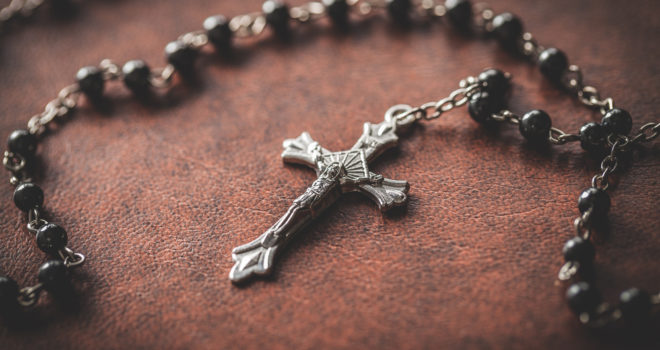How joyful are the rosary’s joyful mysteries?
Growing up praying the Holy Rosary as a young man, I used to see the joyful mysteries of the Rosary as implying that these are the mysteries in which there was no suffering at all compared to the Sorrowful mysteries. However, on closer meditation of the Scriptures and contemplation of the Gospel scenes, and after some life experiences, I quickly realized that these joyful mysteries, especially the fourth joyful mystery, the Presentation of the baby Jesus in the Temple, were all tinged with suffering in one form of another.
By humbly presenting Jesus in the Temple at the right moment, Mary brought great joy to Simeon, Anna, and indeed to all mankind in all generations. But she also received the painful prophecy of Simeon that she will share deeply in the pains that Jesus would experience when He would be rejected and contradicted by the Jews: “This child is destined to be a sign that will be contradicted and you yourself a sword will pierce.” She will live the rest of her life with this painful prophecy in her heart and mind. Every look at Jesus or every thought of Him must have driven the sword of sorrow and pain ever deeper into her loving heart. Mother and Son indeed shared the same destiny of the Cross at every moment.
If we are ever going to grasp the meaning of true joy and experience this true joy in our world, it is very important for us to ask ourselves why we call this mystery a joyful mystery even when we see the pains and sufferings of the Savior and His Mother so clearly prophesied.
These joyful mysteries show us that true joy is not the absence of suffering or pain but joy can co-exist with suffering. True joy is present when we recognize the presence of God in our lives and strive to share this loving presence with others. The joyful mysteries of the Rosary are indeed joyful not because they do not contain suffering and pain. Think of Mary’s suffering during Joseph’s dilemma over her pregnancy or the suffering in her journeying to Bethlehem with an advanced pregnancy and giving birth to Jesus in a poor manger or her agonizing searching for Him in Jerusalem for three days. The mysteries are called Joyful because the invisible God first became present and recognizable in these mysteries. Mary’s joy lies in her first of all recognizing God’s presence with her and her willingness to bring Him to others at great costs to herself.
Who are the joyful ones in the feast of the Presentation? The aged Simeon, weighed down with the suffering of old age and almost wearied by waiting for the “Christ of the Lord,” was filled with so much joy firstly because he recognized Jesus as the “light of revelation to the Gentiles and glory for the Israelite people.” He did not only recognize Jesus as the Messiah present in Mary’s arm, but Simeon was not satisfied in being a “righteous and devout” man; on the other hand, he “looked for the consolation of Israel,” desiring so much that others (his fellow Israelites) too get to know that the Messiah was in their midst. He obviously still had to deal with his old age, but his joy was now so great that he was willing to die at that moment: “Now lord you can let your servant go in peace.”
Anna the Prophetess is another example of joy that comes from recognizing God in her life and striving to bring Him to others. She was “advanced in years” and had “lived as a widow until she was eighty-four.” She recognized Jesus as the Redeemer in her presence, gave “thanks to God and spoke about the child to all who were awaiting the redemption of Jerusalem.” She was not content with her “worshipping night and day with fasting and prayer.” Her joy was not one that came from a cessation of her suffering in loneliness but from this recognition of God with her and her willingness to share this presence with others.
Lastly, the Mother of God stands out as a woman of deep joy even in her pains. She was the first to recognize God in her infant son through her faith in the words of the Angel Gabriel, “The Lord is with you.” She was ready to make any sacrifice to bring Him to others even when it involved great pains for her. She was not satisfied in being the privileged Virgin Mother of God but strove to bring this precious gift of divine presence to others. She brought Him to Elizabeth her relative with haste after the Annunciation, she brought Him into the home of St. Joseph, she showed Him to the magi and the shepherds at the moment of His Nativity, and she presented Him in the Temple, enduring Simeon’s painful prophecy of her coming sufferings and pains. Simeon’s painful prophecy did not hinder her strong resolve to share this gift with others. She will later stand at the foot of the Cross, united in heart and mind to Jesus till the end, so that we all may have the very same life that throbbed in her pure soul. This is why she is rightly called Cause of our joy.
My brothers and sisters in Christ: where do we seek our joy today? If our idea of joy is absence or cessation of all suffering and pain, then we may never experience this true joy in this world. In this world there will always be something to cause us pain and suffering. And if life appears to be a breeze, there is always the thought of death and its attendant uncertainty to remind us that this world is a valley of tears. We are creatures and we are not in control. This is not heaven so there will be suffering and pain in one form or another in this life. It is futile to desire true joy in this world without recognizing God’s loving presence in us and our response of sharing this presence with others.
Let us look to Mary and learn from Mary through the constant meditation on the mysteries of the Holy Rosary. I have found that praying the Rosary with Mary may not take away my pains and sufferings. But praying the Rosary fills me with a deeper sense of God’s loving presence with me in my trials and a desire to share Him with others even when the pains persist. If we constantly look at those mysteries and learn from Mary, she will guide us to the deep interior joy that nothing in this world can give because we will see God with her eyes of faith and desire this same vision for others too.
Jesus presents Himself to us in Holy Communion to make us Temples of God. The letter to the Hebrews tells us that Jesus “shared in our blood and flesh” to destroy the devil and free us from fear. The Almighty God, incapable of suffering, experienced suffering in Jesus Christ because He came to this world to become one like us, to unite Himself inseparably with us so as to help us in our own sufferings: “Because He Himself was tested through what He suffered, He is able to help those who are in need.” Jesus was a man of deep joy, a joy that did not find its source in His worldly condition or status. He was a man of deep joy even as He faced the present and future sufferings of His earthly life because He was filled with the Father’s presence and He was willing to pay the price of bringing us into that loving divine presence even if it meant death on the Cross. It is His own joy that completes our joy. He offers us Himself and His example as the only path to this true joy: “In this world you will have tribulations; but be of good cheer, I have overcome the world.”
With and through Mary, let us follow Jesus along the path of the Cross marked with all the sufferings and pains of this life. God is inseparably united with us and He has promised to be with us till the end of time. If we recognize Him always with us in good and bad times and strive to bring Him to others, we shall indeed find joy even in the midst of all our suffering and pain in this world.
Glory to Jesus!!! Honor to Mary!!!













